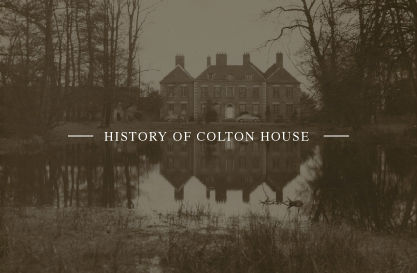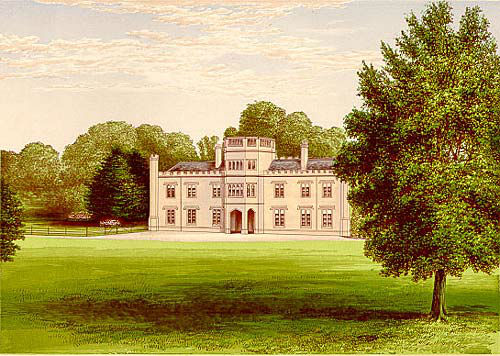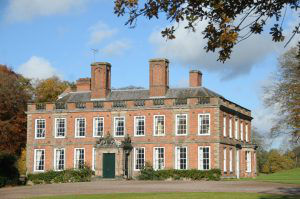
Colton House has the style of a property built in the early 18th Century probably built about 1720.
But there does not appear to be any evidence as to who built it and exactly when. However, there is a lot of information about some of the different people that have lived in the house. Some had connections with royalty, heads of state, and many foreign countries, some were well known in their field and many had local connections.
Over the years the estate and house has moved with the times, but this has been essential for the entity to survive.

The site is reputed to have originally been occupied by a roughly built timber house, in which resided a Saxon Lord who possessed at least four different manors, including Colton. At that time the land is said to have consisted chiefly of swamps, marshes and bogs, with the primitively-designed lord’s house protected by a ditch and wooden palisade. It is described as standing in a field not far from the church, and ancient records show that the property was rented out by Roger of Montgomery to Azeline.
The present house is believed to have been erected in the early 1700s and it is known that Robert Hodgson, John Gomm, David Moilson and George Chambers owned the house but no modern records can substantiate this. The first recorded mention of the present day Colton House was in 1777 when Mr. William Pigott, a gentleman of good family is noted as keeping harriers there. He was in fact 11th in line to the crown, being related to Henry VII. He was educated at Brazenose College Oxford and graduated in 1766 as a Bachelor of Civil Laws.
He married Sophia, only daughter of Sir William Wolseley of nearby Wolseley Hall, Staffordshire who came with a fortune of £22,000 (worth about £1.4 million pounds today. We know that six children were born to the couple and baptised whilst they resided here.
William was the main investor in the long drain which made the lower end of the village, and more importantly the road outside his house more easily passable. On 5th September 1781 Mr. Pigott took out insurance with the Royal Exchange for cover against fire. This covered his brick built and tile dwelling house worth £1,000, his furniture worth £400 and stable and coach house worth £200. For this he paid £2 pounds 5 shillings 6 pence, and he received a firemark number 81603, which is still attached to the front of the house.

In 1789 he inherited the manors of Doddershall and Grendon Underwood in Buckinghamshire; William became Sheriff of Buckinghamshire in 1792, he died in 1802. One of his sons was a JP and became Receiver General for Buckinghamshire in 1827, and another son was rector of Grendon Underwood for 47 years until his death in 1855.
In 1792 John Heyliger Burt moved to Colton House. He was one of the trustees involved in an Act of Parliament to enclose the waste land so that it could be sold or rented out. The money raised went towards the relief of the poor. John married Judith, the daughter of the vicar of nearby Hill Ridware. She had been married before to one of the Okeover family, that could trace its family history back to 1095. They held several Derbyshire manors such as Osmaston and were related to the Anson, Cavendish and Curzon families. Judith’s great grand daughter was a maid of honour at Queen Victoria’s wedding.
John’s father’s family were very rich and held great influence in many of the Caribbean islands. His father was a council member of Nevis with properties there and in Saint Kitts, Barbuda and Antigua. He also lived for many years in Saint Croix and Saint Eustatius. He had five wives and at least 11 children. John’s grandfather was Chief Justice of Saint Kitts, his great grandfather was President of Nevis and his great great grandfather was Deputy Governor of Nevis. His uncle was Governor of the Leeward Islands; retiring from there he became the MP for Great Marlow and had a country estate in Maiden Earley, Berkshire. Other notable people on his father’s side held posts as Speaker of the House of Assembly in Saint Kitts, Attorney General of Saint Kitts and Chief Justice of Western Australia.
His mother was one of the Heyliger family, again of great wealth and influence in many of the Caribbean islands. Her father was Governor of Saint Eustatius 1743– 52 and the family were connected to two USA presidents – John Adams and the Roosevelt’s. There is a map of Saint Eustatius or Statia as it is more generally known on the wall of the first floor corridor.
John was born on Saint Croix in September 1764, now part of the US Virgin Islands but was orphaned by the age of 24. He inherited a plantation on Saint Croix where sugar was grown and processed, mainly by slaves. There is a map of Saint Croix showing the sugar plantations on the first floor corridor – look for a green area labeled Charles Pym Burt, this is John’s father and the estate is called St Johns. He also obtained the estate to the north and called it Judith’s Fancy although it now better known as the Millionaires Row of The Virgin Islands.
John’s son, also called John married Augusta Von Moltke and in 1842 his granddaughter married Field Marshal Count Helmuth Carl Bernhard Von Moltke, chief of staff in the Prussian Army. His great grand nephew Helmuth Von Moltke was involved in trying to tell the world about Hitler and was a founder member of a resistance group. John and Judith lived here to raise their four children. He became the High Sheriff of Staffordshire in 1805 and took out an additional insurance policy with the Sun number 62239 as cover for his pictures valued at £1,000. This firemark is still to be seen on the front of the house.
By 1841, the house was turned into a boarding school, and, in 1851 was called Colton Hall Academy Boarding and Day School. It was being run by Richard Mills, his wife and son, and educated 11 boys as boarders and also two of their younger children as pupils. They also had a general and a house servant.
In 1881 Mr. Charles Albert and Mrs. Hannah Salkeld with their family of five and two servants were in residence. Mr. Salkeld had been a miller in Cumberland and he leased Colton Mill from the Earl of Lichfield; the mill was on land between the present day railway bridge and the river, and has recently been redeveloped. The mill in Domesday times had been used for grinding flour from corn. This changed around 1876 to grinding flint and other materials to make plaster of Paris and cement. It later went on to make colours for paints, asbestos, and roofing tiles.
By 1891 Mr. Frederic Bonney had moved in. He was a Justice of the Peace, and a County Magistrate. The Bonney family was well known locally; from about 1750 they had held positions of influence in Rugeley and the surrounding areas. Charles Bonney was an explorer and politician in Australia becoming a member of the Legislative Council and Commissioner of Crown Lands for South Australia in 1857; he also became a Fellow of the Royal Geographic Society.
Professor Thomas George Bonney, Frederic’s brother, was probably the most widely known and academically distinguished member of the family. He specialised in geology but was also well qualified in theology; he was ordained and held many high ranking offices in the Church and the Societies of the day. Between 1900 and 1921 he was described as being the chief landowner in Colton Parish.
Frederic Bonney was in Australia between 1837 to about 1883 with his brother Edward, working on a sheep station. He made notes on the local aboriginal people in the River Darling area, supported by a collection of photographs which are now on display in a Sydney museum. For this work he was made a Fellow of the Royal Anthropological Institute. He traveled the world bringing back many new trees, plants and pictures to this country.
On his return, he came to live at Colton House and as a keen gardener and naturalist, he restored the large gardens and with his camera recorded many local events. He was a bird enthusiast and bred fine fan-tailed pigeons. In 1895 was appointed the first chairman of Colton Parish Council. He moved to a smaller house in Rugeley in about 1902.
At that time the estate consisted of the mansion house, wilderness (the area to the right of the house if you look at it from the road, where the trees are between us and The Old Rectory), the plantation (the area across the road where the pools where, currently occupied by three houses) and the outbuildings, numerous piggeries, stables, greenhouses and coach house.

In 1910, Captain James Gordon Cavenagh-Mainwaring moved in. He had previously rented a house in Stafford, but having four children in quick succession, he had to move to a bigger property. He was born on 3rd December 1865 in Adelaide and went to University there, becoming a barrister in 1888. In 1897 he joined the Cornwall and Devon Miners Regiment of Artillery Militia, and was appointed Instructor of Artillery in 1899.
He served during the Boer War as Officer in charge of land and water transport at Devonport, then with his regiment at the Royal Garrison Artillery at Plymouth, he was promoted to the rank of Captain in 1901. He later went on to write a history of his regiment which was published in 1913. In 1904 he married Evelyn Dutton, eldest daughter and co-heiress of George Dutton Green, Esq. of Holmfield, Adelaide, South Australia and Constance Evelyn his wife. The Green family came from Dudley and were glassmakers.
In 1914, Gordon Cavenagh-Mainwaring was appointed as recruiting officer at Stoke on Trent, and later that year was ordered to Plymouth as Officer Commanding Fort Bovisand. In 1915 he went to Wolverhampton to raise and command the new 3/3 North Midland Brigade, Royal Field Artillery, with the temporary rank of Major. Later that year, the Brigade was removed to Ripon where it ceased to be an independent command. Major Mainwaring held various commands in the Territorial Force until 1916 when he was transferred to the Territorial Force Reserve. In 1917 he relinquished his commission and at that time he moved from Colton House and took up his residence at Cheltenham, where he remained for over 10 years.
Devoting most of his time to Local Government affairs, he held numerous posts including Chairman of the Cheltenham Board of Guardians, and of the Cheltenham, Tewkesbury and Winchcombe Assessment Committee, a County Councilor for Gloucestershire, Borough Councilor for Cheltenham and a member of many committees. In 1926 at the time of the general strike, he was sworn in as a special constable and appointed Section Commander.
In December 1928 he went to live at Whitmore Hall, the Cavenagh-Mainwaring family home. He died in 1938, but the family still live at Whitmore Hall which is set in the small village of Whitmore, four miles south east of Newcastle-Under-Lyme in Staffordshire. The hall is sometimes open to the public during the summer.

In November 1931 Eleanor Maud Jackson (Jackie) bought the estate, which comprised approx. 17 acres containing piggeries, gardens, stables, saddle room, store, three cottages, garage, greenhouse, potting shed, boiler room, pleasure grounds, meadow, fish pond, plantation, pasture and shed.
The house was used by the army during the second world war; in 1946 repairs were made to the property and it was converted into six flats, which were then rented out. Jackie gave the estate to her daughter (Olive Maud Hare) as a gift in October 1957 and the kitchen garden, in a walled enclosure a total of 3,200sq yards was sold. This is now called The Paddocks.
In 1977, five of the six flats were sold to the Lawrence family, who turned the five flats back to one house and set about refurbishing what had become a building at risk.
It was structurally reinforced which allowed temporary props to be removed. All the plasterwork was restored to its original condition with the help of experts from Bristol. In 1989 it was extended to allow a more flexible use for the property. Refurbishment continued on all 47 windows and the cleaning of all the stone work. The house’s insulation was improved and it became the first Grade II* listed building to get permission to double glaze its windows. 10 of its 14 bedrooms have been upgraded to modern standards and 11 used for a high quality bed and breakfast.
